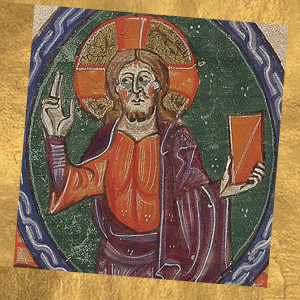St. Scholastica, Virgin, sister of St. Benedetto

“She was capable of more, who loved the more”
Scholastica, first Benedictine nun, lived between 480 and 543. A native of Nursia, she was a very docile disciple of her brother, St. Benedict, with whom she vied for perfection of holiness, in learning the wisdom of the heart: so much so that she is said to have bested even her brother in charity. In his Dialogues, the only reference text with a few references to the life of Saint Scholastica, St. Gregory the Great tells of one episode in particular, which reveals her strong human personality and spiritual depth.
The choice for religious life in the footsteps of her brother
According to reports, Scholastica, daughter of Eutropius, descendant of the ancient Roman senatorial family of the Anicii, and of Claudia, who died immediately after giving birth to twins, was sent to Rome at the age of 12, together with her brother, both of whom were deeply disturbed by the dissolute lifestyle that prevailed in that city. Benedict was the first to retire to a hermitage while Scholastica remained heir to the family, and, revealing detachment from earthly goods, asked her father to be allowed to dedicate herself to religious life, first entering a monastery near Nursia and then moving to Subiaco, following her brother who had founded the Abbey of Montecassino. There, just 7 kilometers away, she founded the monastery of Piumarola, where together with her sisters in religion she followed the Rule of St. Benedict, giving rise to the female branch of the Benedictine Order.
Rule of silence
Scholastica used to recommend observing the rule of silence, and avoiding conversation with people outside the monastery, even if they were devoted visitors. She used to say, “Either speak of God or keep silence, for, what in this world is so worthy of speech?” Of God, Scholastica loved to speak above all with her brother, Benedict, whom she would meet once a year. The place of their spiritual talks was a little house halfway between the two monasteries.
The miracle that challenges Benedict
Gregory tells that in the last of these meetings, dated 6 February 543, shortly before her death, Scholastica asked her brother to continue the interview until the following morning, but Benedict opposed her, saying it would break the Rule. Scholastica then implored the Lord not to let her brother depart, bursting into copious tears: immediately after, an unexpected and violent storm forced Benedict to stay, so that the two did talk all night. Noteworthy is Benedict’s reported initial reaction to the sudden downpour: “Almighty God forgive you, sister. What have you done?” to which Scholastica answered, “See, I have asked you, and He has answered me. Now go out, if you can; leave me and go back to the monastery.” His sister’s riposte could not fail to please Benedict, for he himself had taught her to turn in difficulties to the One to whom everything is possible.
In life and in death united in God
Three days after this meeting, according to the story of Gregory, Benedict was informed of his sister's death by a divine sign: he saw his sister’s soul ascend to Heaven in the form of a white dove. He then desired to bury her in the tomb he had set up for himself and where he too would be buried, a short time later. “As their minds had always been united in God, in the same way the bodies were joined in the same sepulcher.”
Those who arrive today - after fifteen centuries of history - to the majestic abbey of Montecassino, will live the emotion of being before of the tomb of the Holy Brother and Sister, guides to an unbroken chain of God-seekers down through the centuries and into the future.







